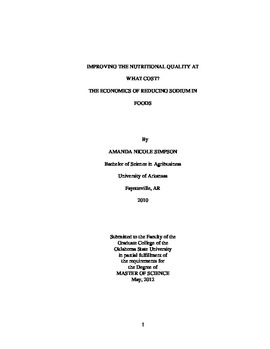| dc.contributor.author | Simpson, Amanda Nicole | |
| dc.date.accessioned | 2014-04-15T18:35:40Z | |
| dc.date.available | 2014-04-15T18:35:40Z | |
| dc.date.issued | 2012-05-01 | |
| dc.identifier.uri | https://hdl.handle.net/11244/8352 | |
| dc.description.abstract | Salt serves a multifaceted purpose in food products for producers and consumers. Producers use sodium as a preservative to increase shelf life, and many consumers often have a preference for salty, long-lasting, and convenient food products. In recent years, a majority of health professionals agree that reducing sodium consumption in one's diet would improve their health. However, this idea is not fully supported by all, and some research rejects the theory or does not find conclusive evidence. In an attempt to make Americans healthier, recent FDA recommendations are aimed at the food industry by asking agribusinesses to limit the amount of sodium in food products and thus in American diets. Now, the FDA is considering changing the voluntary recommendation to a mandatory policy. For a variety of reasons, this could lead to a high economic cost for the entire food industry. The main purpose of this research is to determine the impact to food processors if a sodium reduction policy is implemented. To estimate the impact of a reduced sodium policy, a survey was distributed to food manufacturers in Oklahoma and the surrounding area, and a sodium cost function calculated to find the estimated cost. Additional questions provided opportunity to use an ordered logit model for agribusinesses to rate various sodium policy options based on the desirability. A choice experiment was created between two regulatory environments in an experimental design where changes in health related issues vary by either 0% or 10%, which will allow a willingness to accept term for each policy to be estimated. The results provided that when each firm has equal weight, Oklahoma food manufacturers would be willing to forfeit $1.2 million to avoid a sodium reduction policy. However, when each company is weighted through their total employment, that amount increases to nearly $4.9 million. This is the more conservative estimate; in the total cost function, the results imply that Oklahoma food manufacturers alone predict that they would have a total estimated cost of over $140 million with a sodium reduction policy. While the ordered logit model did not return significant results, the most likeable solution to addressing the reduced sodium debate for food manufacturers is to either maintain the current recommendation or implement educational activities which describe sodium's adverse health effects. | |
| dc.format | application/pdf | |
| dc.language | en_US | |
| dc.publisher | Oklahoma State University | |
| dc.rights | Copyright is held by the author who has granted the Oklahoma State University Library the non-exclusive right to share this material in its institutional repository. Contact Digital Library Services at lib-dls@okstate.edu or 405-744-9161 for the permission policy on the use, reproduction or distribution of this material. | |
| dc.title | Improving the Nutritional Quality at What Cost? The Economics of Reducing Sodium in Foods | |
| dc.type | text | |
| osu.filename | Simpson_okstate_0664M_12114.pdf | |
| osu.college | Agricultural Sciences and Natural Resources | |
| osu.accesstype | Open Access | |
| dc.description.department | Department of Agricultural Economics | |
| dc.type.genre | Thesis | |
| dc.subject.keywords | economics | |
| dc.subject.keywords | health | |
| dc.subject.keywords | nutrition | |
| dc.subject.keywords | policy | |
| dc.subject.keywords | reduction | |
| dc.subject.keywords | sodium | |
